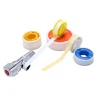PTFE thread tape can withstand temperatures from -450°F to +500°F (-268°C to +260°C). PTFE itself has a high melting point of around +327°C, but it starts to deteriorate at temperatures between +200°C and +260°C. PTFE decomposes above 350°C (662°F) and undergoes pyrolysis above 400°C (752°F).
PTFE resin is a polymer composed of repeating tetrafluoroethylene monomers with the molecular formula (CF2-CF2)n. It is inert and compatible with a wide range of materials. Use Blue Monster on threads made of galvanized steel, iron, brass, copper, aluminum, stainless steel, polyethylene, polypropylene, PVC, CPVC, ABS, fiberglass and more. It can be used with pipelines carrying:
●Concentrated acid and dilute acid
●Alcohols, gasoline alcohol
●Aliphatic solvents, aromatic solvents, chlorinated solvents
●liquid ammonia
●Concentrated caustic alkali
●Compressed air, steam, water
●Cutting oil
●diesel fuel oil
●Ethylene glycol, glycerin
●fatty acid
●Heating oil, kerosene
●Hydraulic oil, hydraulic oil
●Hydrogen, gaseous and liquid, Inert gases, gaseous and liquid
●jet fuel
●Ketones, petroleum solvents
●Liquefied petroleum gas, natural gas
●Mineral oil, vegetable oil
●Nitrogen, gaseous and liquid
●soap, liquid




NOTE: Keep Mill-Rose Blue Monster Thread Sealing Tape clean. Put the clip on the spool back into place after use. Store in a clean place. PTFE is chemically resistant to virtually all media, with some exceptions. Alkali metals such as the elements sodium, potassium and lithium should be avoided. These alkali metals remove fluorine from polymer molecules. PTFE can handle extremely strong oxidizing agents such as fluorine (F2) and related compounds such as chlorine trifluoride (CIF3), but great care must be taken. Since fluorine is absorbed into the resin, the mixture becomes sensitive to fire sources, such as 80% NaOH or KOH, metal hydrides such as borane (e.g. B2H6), aluminum chloride, ammonia (NH3), Certain amines (R-NH2), imines (R-NH) and 70%. Use nitric acid at temperatures close to recommended maintenance levels.
Types of PTFE tape
Originally, PTFE tape was manufactured in only one color; that was white. Due to the huge demand in the pipe industry, manufacturers also started producing pipes in other colors. There are six types of PTFE tapes based on the tape's color, functionality and density. These properties are different for each type of tape and we will discuss them here.
White PTFE
White PTFE tape is a single density tape for use with 3/8 inch NPT threads only, but can also be used on low pressure residential water applications such as garden hoses, faucets, cooking gas connections, etc.
yellow tape
The yellow tape is dual density and can be used on natural gas fittings or propane/butane fittings. It is a gas type because it can be tightened and loosened at any time without losing its seal.
Red PTFE
Red PTFE tape is triple density tape. The tape packaging is red, but the color of the tape itself is light pink. It is suitable for all joints ½ diameter or larger. It is also suitable for high-pressure residential water pipes, with an optimal operating temperature of 190° F and a pressure of 150 psi.
Green PTFE tape
Green PTFE tape is an oil-free tape used for pipelines transporting oxygen, such as medical oxygen cylinder pipelines or oxygen welding pipelines.
Copper-colored PTFE tape
Copper-colored PTFE tape is used as a thread lubricant rather than a thread sealant and also contains copper particles. It is used as a thread lubricant for pipes and bolts that require mechanical applications and do not require physical sealing.
Silver PTFE tape
Silver PTFE tape contains grounded or impregnated nickel particles. Impregnated nickel granules are better than powdered nickel. It can be used as both a sealant and a lubricant. It is designed to prevent binding when used on stainless steel, brass and aluminum threaded connections and to prevent galling when using stainless steel. PTFE is approved as a thread sealant only when used correctly.










